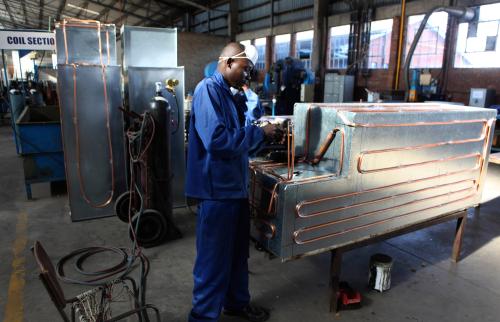Sunday, November 20 marked another United Nations “Africa Industrialization Day.” If anything, the level of attention to industrializing Africa coming from regional organizations, the multilateral development banks, and national governments has increased since the last one. This year, the new president of the African Development Bank flagged industrial development as one of his “high five” top priorities. In its 2016 Global Economic Prospects report the World Bank pushed “creating the conditions for a more competitive manufacturing sector” in Africa as a response to dependence on commodities. Tanzania’s new five-year development plan is titled Nurturing Industrialization for Economic Transformation and Human Development.
However, the growth in rhetoric has not been matched by the reality of industrial growth. Africa’s average share of manufacturing in GDP is still about 10 percent, half of what would be expected from the region’s level of development, and while manufactured exports are growing, they are a tiny fraction of global trade. Africa’s share of global manufacturing remains less than two percent. With the possible exception of Ethiopia, it is hard to find country-level examples of dynamic export-oriented industrialization, despite the region’s relatively low real wages.
Last year I argued that bad policies—many of them the product of the International financial institutions—have played a major role in holding back Africa’s industrialization, and pointed to the book Made in Africa: Learning to Compete in Industry (Brookings Institution Press) as a source of new policy directions. I still believe that better designed policies are critical to Africa’s industrial success, but the harsh reality is that many of the policy ideas in Made in Africa have been implemented successfully in other parts of the world but have not succeeded in Africa.
Take for example the case of special economic zones (SEZs). SEZs are industrial locations established to attract foreign direct investment (FDI) and/or promote exports. They have been used successfully as an instrument of industrial development all over the world, from the Dominican Republic to Jordan to China. Most African SEZs, however, are underperforming. They have low levels of investment and exports, and they create few jobs. The vast majority of African SEZs lack the physical, institutional, and regulatory infrastructure needed to attract global investors.
This poor performance is not due to lack of knowledge. Legions of international consultants offer advice, and countries with successful SEZs, such as China, provide technical assistance and financial support for SEZ development. Many African governments have been the recipients of these initiatives. Rather, it suggests that the failure of SEZs in Africa reflects a deeper set of failures in the practice of industrial policy.
In a new book The Practice of Industrial Policy: Government–Business Coordination in Africa and East Asia (Oxford University Press, forthcoming) Finn Tarp and I find that while implementing industrial policy is both complex and country specific, successful efforts to push the pace of industrial development share some common characteristics. Foremost among these is the role of leadership. Commitment from the top has characterized all of the countries that have achieved an industrial transformation.
One virtue of having a high-level champion is that it identifies the person who has the job of explaining why the policy agenda looks as it does and who can be held politically responsible for things going right or wrong. A second reason why high-level leadership is critical is the need for coherence within government in following up and implementing policy decisions.
When the responsible party is the head of state or government it raises both the visibility of the industrial policy process and the level of accountability for its implementation. In Africa all too frequently top political leadership has chosen to delegate the industrial development agenda to lower levels of government. To move from rhetoric to reality that will need to change.
The Brookings Institution is committed to quality, independence, and impact.
We are supported by a diverse array of funders. In line with our values and policies, each Brookings publication represents the sole views of its author(s).







Commentary
Africa Industrialization Day: Moving from rhetoric to reality
November 21, 2016